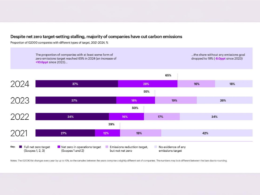For the first time, the world’s cities are seeking over US$100 billion to build a climate-resilient future, according to new data from the CDP and the Global Covenant of Mayors for Climate & Energy (GCoM). The 2025 Global Snapshot report reveals that while cities’ ambitions are rising sharply, the funding needed to deliver climate projects remains critically under-supplied.
Released as the COP30 Local Leaders Forum opens in Rio de Janeiro, the analysis shows that the total investment required for urban climate projects jumped from US$86 billion in 2024 to US$105 billion in 2025—a 22 percent increase. The data, drawn from 2,164 projects disclosed by 507 cities across 62 countries, reflects both mounting urgency and widening financial gaps.
In 2025, the top sectors by project volume are buildings and energy efficiency (420 projects), followed by green infrastructure (338) and transport (336). Notable initiatives include Porto’s Transport Fleet Modernisation Project, which aims for 43 percent of buses to be electric by 2027; Freetown’s “Treetown” project, which has planted 1.2 million trees; and Buenos Aires’ Community Distributed Generation programme, designed to harness 10 percent of the city’s solar potential and cut 217,000 tons of CO₂ annually.
Despite this growing pipeline, 87 percent of projects are seeking funding, and nearly half (49 percent) have yet to secure any financing. The gap is especially pronounced in emerging markets, where 40 percent of projects require full funding compared to 22 percent in developed economies. Only 7 percent of projects pursuing finance are targeting strictly private sources, while nearly half remain in early development stages.
Investment needs are heavily concentrated in advanced economies, which account for 83 percent of total reported demand—led by the United States (44 percent) and the United Kingdom (23 percent)—even though emerging-market cities represent 40 percent of all projects.
CDP’s companion analysis, Protected Places, underscores how a lack of finance prevents many local climate plans from reaching operation. Only 5 percent of climate actions in India are fully implemented, compared with 75 percent in Japan and 86 percent in China, while Latin America (23 percent) and Africa (31 percent) lag significantly behind.
Reviewing nearly 5,000 projects disclosed between 2020 and 2024 worth US$266 billion, CDP found that nature-based initiatives—covering biodiversity, water resilience and green spaces—are the fastest-growing category, increasing from 7 percent of projects in 2020 to 15 percent in 2024.
Despite record demand, the US$105 billion disclosed this year is only a fraction of the US$4.5 trillion cities require annually to mitigate and adapt to climate impacts. Less than 10 percent of global climate finance currently reaches local governments. Ahead of COP30, CDP and GCoM are urging governments and investors to give cities direct access to climate finance and integrate urban investment needs into nationally determined contributions (NDCs) and climate strategies.
They also call for innovative financial instruments, stronger multilevel governance, and expanded climate disclosure to attract private investment and ensure national policies align with local needs.
“Cities, their people and businesses sit on the front line of climate change,” said Katie Walsh, Head of City Climate Finance at CDP. “Our latest Snapshot reveals both the scale of their response and the glaring scale of the investment needed—now topping US$100 billion for the first time. The financing tap for cities, especially in developing economies, must be fully opened to turn plans on paper into projects on the ground.”
Asma Jhina, Senior Adviser for Urban Climate Finance and Inclusive Action at GCoM, added: “The gulf between city climate ambition and critical finance remains stark. Almost half of the more than 2,000 projects disclosed are unfunded. Cities are stepping up, but they cannot do it alone—urgent access to funding is essential to deliver their climate action plans.”



















